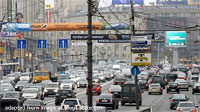Road rage: Reality in Russia; 10 facts about Russian roads that will make you weep

(Moscow News – themoscownews.com – Anna Arutunyan – November 7, 2013)
Common wisdom has it that all of Russia’s ills originate in two simple things: fools and roads. Indeed, one of the biggest factors holding back the country that occupies one-sixth of the world’s landmass may be its transportation arteries – or lack thereof.
1) Some better off on horses
In Russia, roads are at their worst in fall and spring, when rains and melting snow make them impassable. This seasonal problem is so widespread that the Russian language has several words for it, including rasputitsa and bezdorozhe. Last week, things apparently got so bad that Moscow region Governor Andrei Vorobyov even suggested local officials give up their Land Cruisers for horses.
2) The vanished asphalt mystery
Construction workers repairing the M9 highway connecting Moscow and Riga in the summer of 2012 removed a layer of asphalt – and somehow failed to replace it until spring. As a result, drivers just a few hundred kilometers from Moscow found themselves stuck in the dirt. A 4-kilometer segment of the highway, which underwent a major overhaul just a few years ago, decayed so badly that it will require major reconstruction. Police issued an unspecified administrative fine to companies responsible for reconstructing the highway.
3) All roads lead to Rome
“Countries with large territories, like China, the United States or Canada, tend to have a road grid,” said Mikhail Blinkin, head of the Institute of Transportation Economics and Politics at the Higher School of Economics (HSE). “In Russia, it’s not a grid, but a star, with all roads going to Moscow. The country has the same road configuration as it did 100 years ago, under the tsars. Two-thirds of our [road] expenditures are focused within a 50-kilometer radius of Moscow. This doesn’t exist anywhere else in the world.”
4) The Far East’s Highway from Hell
Aside from the Trans-Siberian Railway, there’s basically one federal route that connects Moscow with the Far East. In southern Siberia, that route branches north up to Yakutsk and Magadan and south to Khabarovsk and Vladivostok. The north route is the notorious A360 Federal Highway, also known as the Lena Highway. Although it’s a federal road, whole sections have no asphalt. It gets so bad in late spring, when the snow melts, and in late summer, when the rains begin, that it’s been christened the Highway from Hell. Drivers are advised to stock up on survival gear and canned goods.
5). Millions can’t travel for months
One in 10 Russians (about 14 million people) are cut off from transportation networks that are functional year-round, according to 2011 findings of a government panel cited by Vedomosti. Millions of people have no access to train stations, airports or federal roads in fall and spring, when rural roads are impassable.
6) Spending less than neighbors
In 2012, Russia built 266.4 kilometers of roads, according to figures provided by Avtodor, the Federal Road Agency, part of the Transportation Ministry. Avtodor plans to build 479 kilometers of federal roads by the end of this year, and 519 kilometers by the end of 2014. That’s still very little, according to Blinkin. In China, for instance, 7,000 kilometers of expressways were built in 2011 alone.
7) Abysmal road density rate
Russia has just 5.4 kilometers of roads per 100 square kilometers of territory, according to Rosstat, the State Statistics Service. By comparison, China has a road density of 41.8 kilometers. Is this due to the fact that Russia is cold and sparsely populated? Not really. Canada, which isn’t much warmer, has a road density nearly twice that of Russia – 10 kilometers, according to the World Bank.
8) Building roads in Russia a ‘luxury’
Figures diverge on this one, but the general consensus is yes, building roads in Russia costs more than in Europe – about 2.5 times more, according to Blinkin. In 2009, then-President Dmitry Medvedev said that construction costs were so high that spending money on roads had become “a luxury.” He didn’t mean to say that Russia shouldn’t build roads, but that officials should sort out costs before they spend more. Avtodor insists that on average, it takes 67.9 million rubles ($2.1 million) to build a kilometer of road, 20 to 30 percent less than in the United States or Europe. What really drives up costs are the distances building materials have to cover, according an e-mailed note from Avtodor. While building materials may only have to travel 40 kilometers to get to Arkhangelsk, the distance grows to 1,500 kilometers to build a federal road connecting Chita and Khabarovsk. By contrast, the average distance materials travel in Europe is between 20 and 40 kilometers.
9) Nightmarish bribery costs
Corruption eats away up to 70 percent of local and regional tenders for road construction, according to 2011 findings by a panel of experts from the HSE and the Moscow State Automobile and Road Technical University.
10) Historic legacy a problem
According to Blinkin, Russia suffered a historical lag in road building. Unlike China and the United States, “we never had a road-building era,” he said. “At the end of the Soviet Union, there were 70 automobiles per 1,000 people. Road-building was never a priority.”
